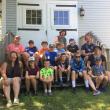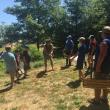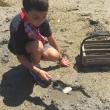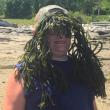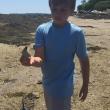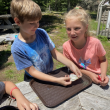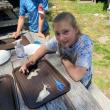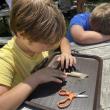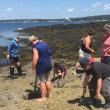Local kids attend Burnt Island summer day camp
 Students from the Boothbay Region during the second week of Burnt Island summer day camp, from left, front: Olivia Hardwick, Blake Durgan, Mason Wenners, Brady Baldwin, Sam Cooper; back row, from left: Byran Hills, Isaac Meyers, John Cooper, James Barter, Eben Robinson. Missing from photo: Xavi Hall. LISA KRISTOFF/Boothbay Register
Students from the Boothbay Region during the second week of Burnt Island summer day camp, from left, front: Olivia Hardwick, Blake Durgan, Mason Wenners, Brady Baldwin, Sam Cooper; back row, from left: Byran Hills, Isaac Meyers, John Cooper, James Barter, Eben Robinson. Missing from photo: Xavi Hall. LISA KRISTOFF/Boothbay Register
 Lead teacher/counselor Libby Zipperer teaches the kids the proper, and safe way, to use a clam rake outside the Burnt Island Education Center. LISA KRISTOFF/Boothbay Register
Lead teacher/counselor Libby Zipperer teaches the kids the proper, and safe way, to use a clam rake outside the Burnt Island Education Center. LISA KRISTOFF/Boothbay Register
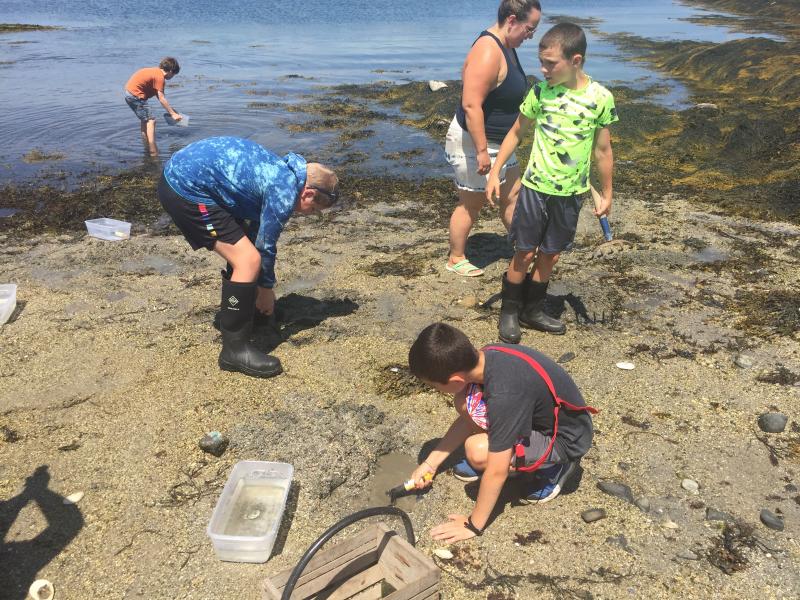 Let the clam digging begin! LISA KRISTOFF/Boothbay Register
Let the clam digging begin! LISA KRISTOFF/Boothbay Register
 First live clam of the day - there were quite a few that had passed on. LISA KRISTOFF/Boothbay Register
First live clam of the day - there were quite a few that had passed on. LISA KRISTOFF/Boothbay Register
 The search for baby crabs and lobsters ... LISA KRISTOFF/Boothbay Register
The search for baby crabs and lobsters ... LISA KRISTOFF/Boothbay Register
 Byran Hills models the latest in nautical wigs. LISA KRISTOFF/Boothbay Register
Byran Hills models the latest in nautical wigs. LISA KRISTOFF/Boothbay Register
 Olivia begins her dig. LISA KRISTOFF/Boothbay Register
Olivia begins her dig. LISA KRISTOFF/Boothbay Register
 James Barter has dug up a live one .. clam, that is. LISA KRISTOFF/Boothbay Register
James Barter has dug up a live one .. clam, that is. LISA KRISTOFF/Boothbay Register
 Byran Hills is getting right into it. LISA KRISTOFF/Boothbay Register
Byran Hills is getting right into it. LISA KRISTOFF/Boothbay Register
 Cameron Mayotte and Sophia Gatner-Koplau, first week campers. Courtesy of Jennifer Lassen
Cameron Mayotte and Sophia Gatner-Koplau, first week campers. Courtesy of Jennifer Lassen
 Nets and basins ready for use on the mudflats. LISA KRISTOFF/Boothbay Register
Nets and basins ready for use on the mudflats. LISA KRISTOFF/Boothbay Register
 Sailor’s valentines were a morning project. LISA KRISTOFF/Boothbay Register
Sailor’s valentines were a morning project. LISA KRISTOFF/Boothbay Register
 Yikes! It’s squid dissection time. Courtesy of Jennifer Lassen
Yikes! It’s squid dissection time. Courtesy of Jennifer Lassen
 OK - let’s do this. LISA KRISTOFF/Boothbay Register
OK - let’s do this. LISA KRISTOFF/Boothbay Register
 Burnt island mudflats - they can dig it. LISA KRISTOFF/Boothbay Register
Burnt island mudflats - they can dig it. LISA KRISTOFF/Boothbay Register
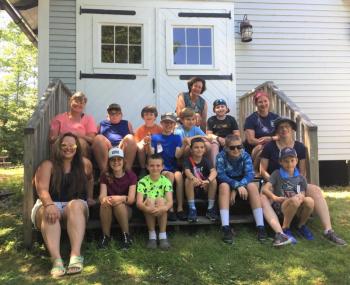 Students from the Boothbay Region during the second week of Burnt Island summer day camp, from left, front: Olivia Hardwick, Blake Durgan, Mason Wenners, Brady Baldwin, Sam Cooper; back row, from left: Byran Hills, Isaac Meyers, John Cooper, James Barter, Eben Robinson. Missing from photo: Xavi Hall. LISA KRISTOFF/Boothbay Register
Students from the Boothbay Region during the second week of Burnt Island summer day camp, from left, front: Olivia Hardwick, Blake Durgan, Mason Wenners, Brady Baldwin, Sam Cooper; back row, from left: Byran Hills, Isaac Meyers, John Cooper, James Barter, Eben Robinson. Missing from photo: Xavi Hall. LISA KRISTOFF/Boothbay Register
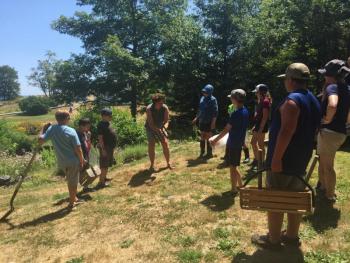 Lead teacher/counselor Libby Zipperer teaches the kids the proper, and safe way, to use a clam rake outside the Burnt Island Education Center. LISA KRISTOFF/Boothbay Register
Lead teacher/counselor Libby Zipperer teaches the kids the proper, and safe way, to use a clam rake outside the Burnt Island Education Center. LISA KRISTOFF/Boothbay Register
 Let the clam digging begin! LISA KRISTOFF/Boothbay Register
Let the clam digging begin! LISA KRISTOFF/Boothbay Register
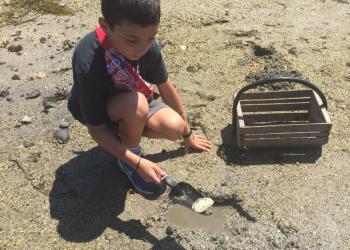 First live clam of the day - there were quite a few that had passed on. LISA KRISTOFF/Boothbay Register
First live clam of the day - there were quite a few that had passed on. LISA KRISTOFF/Boothbay Register
 The search for baby crabs and lobsters ... LISA KRISTOFF/Boothbay Register
The search for baby crabs and lobsters ... LISA KRISTOFF/Boothbay Register
 Byran Hills models the latest in nautical wigs. LISA KRISTOFF/Boothbay Register
Byran Hills models the latest in nautical wigs. LISA KRISTOFF/Boothbay Register
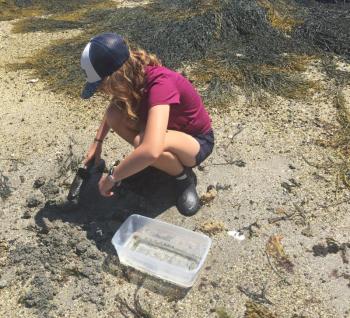 Olivia begins her dig. LISA KRISTOFF/Boothbay Register
Olivia begins her dig. LISA KRISTOFF/Boothbay Register
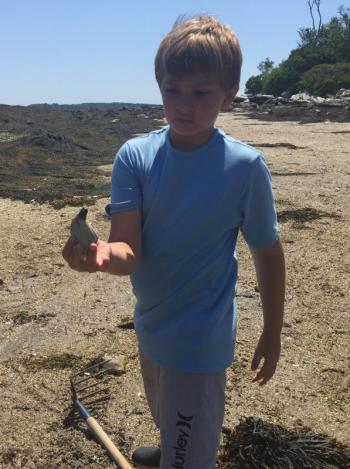 James Barter has dug up a live one .. clam, that is. LISA KRISTOFF/Boothbay Register
James Barter has dug up a live one .. clam, that is. LISA KRISTOFF/Boothbay Register
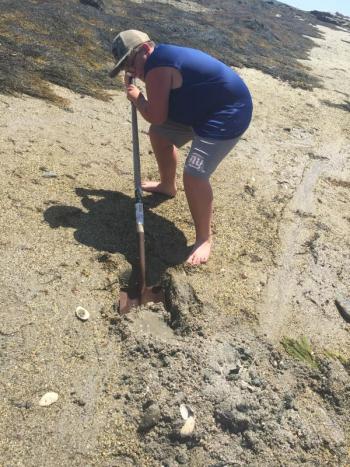 Byran Hills is getting right into it. LISA KRISTOFF/Boothbay Register
Byran Hills is getting right into it. LISA KRISTOFF/Boothbay Register
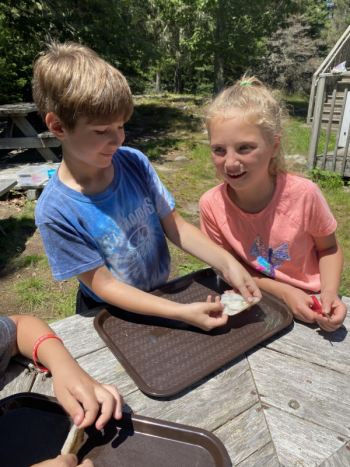 Cameron Mayotte and Sophia Gatner-Koplau, first week campers. Courtesy of Jennifer Lassen
Cameron Mayotte and Sophia Gatner-Koplau, first week campers. Courtesy of Jennifer Lassen
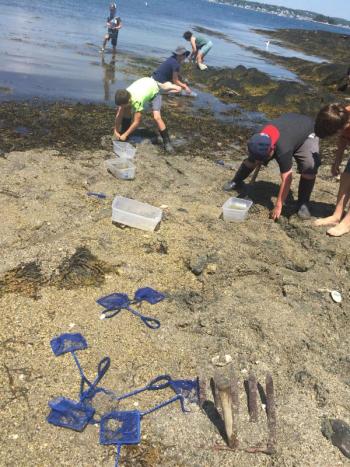 Nets and basins ready for use on the mudflats. LISA KRISTOFF/Boothbay Register
Nets and basins ready for use on the mudflats. LISA KRISTOFF/Boothbay Register
 Sailor’s valentines were a morning project. LISA KRISTOFF/Boothbay Register
Sailor’s valentines were a morning project. LISA KRISTOFF/Boothbay Register
 Yikes! It’s squid dissection time. Courtesy of Jennifer Lassen
Yikes! It’s squid dissection time. Courtesy of Jennifer Lassen
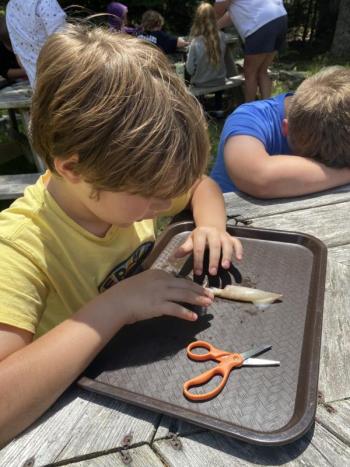 OK - let’s do this. LISA KRISTOFF/Boothbay Register
OK - let’s do this. LISA KRISTOFF/Boothbay Register
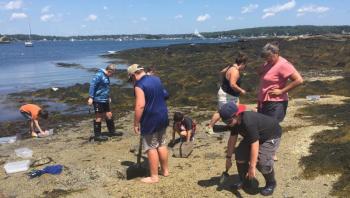 Burnt island mudflats - they can dig it. LISA KRISTOFF/Boothbay Register
Burnt island mudflats - they can dig it. LISA KRISTOFF/Boothbay Register
Maine summer camps. There are 125 of them according to MaineSummerCamps.org. You can scour the listings, but there is only one summer camp on an island in the ocean – Burnt Island, part of Southport Island. Burnt Island’s history of summer camps began in the early 2000s for Maine elementary school students.
Last month, summer camp resumed at Burnt Island Light, completely restored in 2021 and its 200th anniversary observed in November. And, it was free for the 35 summer day camp kids – all from the Boothbay Region Elementary School - who were ferried to and from the island aboard the Balmy Days Wednesday – Friday, July 6-8; 20-22 and 28-30.
First week campers: Audrey Robinson, Carson Cook, Cora Robinson, Harrison Clark, Kaylee Wayda, Polly Nadeau-Miller, Ryder Baker, Sophia Gatnar-Koplan, Cameron Mayotte, Azalea Averill, Landyn Rego, Jacob Verge. Meyer Phelps. William Lassen; second week: Olivia Hardwick, Blake Durgan, Mason Wenners, Brady Baldwin, Sam Cooper; Byran Hills, Isaac Meyers, John Cooper, James Barter, Eben Robinson. Missing from photo: Xavi Hall; Third week: Asher Whitt, Briar Johnson, Maddox Hutchinson, Finn Leeman, Catalia Curtis, Iliya Sanborn, Kaiden Cusumano, Rowan Barter, Savannah Alley, Meabh Hennessy.
Teacher/instructors were: Libby Zipperer - lead instructor and organizer - RSU 1 Bath: Emelia Petroski - AOS 98 Boothbay Harbor; Sarah Currier - Edgecomb Eddy School; and Jennifer Lassen, Boothbay Harbor.
These summer day camps were sponsored by Lighthouse Education & Nautical Studies (LENS) in thanks to a summer resident's desire to provide local youth with ultimate, learning experiences at the perfect outdoor school. The organization's founder, Elaine Jones, provided teacher training for the camp's instructors utilizing activities she had developed as the island's former keeper and education director.
What did they do in paradise? A lot … (and man was it hot!!) check it out: nature journaling to record their observations through drawing and prose; lobstering with Boothbay Harbor lobsterman Clive Farrin; make fish prints, learn about lobsters – how and why they must be measured, banding their claws, etc.; tidepooling and learning about the intertidal zone, gathering species with buckets and nets; compass hike treasure hunt at the beach area, island bingo; stories and lessons about lighthouses, including stories from former lighthouse keeper Steve McCullough and his wife Nancy; tour of Burnt Island Lighthouse and up to the tower; visit through house history museum walkway then down to the boathouse and oil house; more recording in nature journals.
They hunted for objects to make an “explorer’s necklace” on the beach while talking about beaches; collect other beach treasures for making Sailor’s Valentines; introduction to using a GPS and taking a walk; learning about “stonewall dragons” – why were stonewalls used?; treasure map making (heavy art paper is used and tea used for stain ing and “burnt” edging. Service project: scouting the island for trash and picking it up; squid dissection; mudflat dig using clam rakes and shovels to find … yep, clams!; reading navigational charts; fishing on the dock, beach combing. And .. clean up!
Before heading out to the mudflats after lunch break in the ed center (it was very, very hot), Zipperer demonstrated how one should, and should not, use a clam rake ... and down to the shoreline they went. John Cooper decided to make a moat after the water kept flooding the hole he was digging in search of clams, sandworms or bloodworms. As each child found a clam or worm they called out “Found one!” and then added it to their plastic container of water.
Zipperer and the other teacher volunteers went out in the water to look for baby lobsters. And find one she did, but the young crustacean whipped one of its claws in her direction and she begged off quickly! Zipperere did, however, bring back some sea weed that Byran wore as a hat … what a stylish sport! They also came up with a few decent-sized crabs for the containers. Afterward they talked about the sea creatures - and vegetation – before returning it all to the water. Then it was back to the education center for cold drinks and navigational chart reading.
Zipperer, a grade 5-6 teacher who spoke at the 200th anniversary event last August, has been bringing students from her school district to the island for many years. She emphasized how important it was for the local kids – Boothbay Region – to be on the island. “This is their island, in their own backyard. And not many of them have been here before.”
Byran Hills had been to Burnt Island before, lots of times. His sister Hannah portrayed one of the Muise sisters in the Burnt Island Living History Tour (begun way back in 2003), and his mom is Capt. Heather Hills (one of the “women of the working waterfront” honored during the 60th Boothbay Harbor Windjammer Days Festival in late June); and Olivia Hardwick said she’d been to the island when she was little.
Zipperer noted the curriculum used for the camps was developed by Elaine Jones who aligned it with the state’s science and social studies standards for grades 4-6. The counselors/teachers had to choose from 100 activities for campers that would be done as teams.
“Burnt Island is really a science, history, and social studies summer camp,”Zipperer said. “And this year camp was free for the local kids who need to learn about their own island – and to take a break from technology. That’s why we used a compass and then a GPS device.”
In addition to the fun learning experience during the camps, students learn about respecting the environment and the importance of the island’s ecosystem. There’s a learning activity called Flotsam and Jetsam in which students learn how to track trash, then pick it up be it a lobster trap washed ashore, or styrofoam. They learn everyone who comes to the island is one of its stewards.
And as stewards, it’s always best to leave the island better than it was before they came. For instance, the first week’s group scraped the skiff down at the boathouse. It’s something different each time. It’s Burnt Island tradition.
Zipperer’s first trip to Burnt island was with her daughter’s fourth grade class at Turner Elementary in 2008. The following year, after taking the “Discovering Burnt Island” curriculum for teachers, Zipperer began bringing her 5th and 6th grade students. “I have kids who connect with me through Facebook after all these years who ask me if I still bring kids out to Burnt Island,” Zipperer said. “And I am – they’re mostly from Jay, Rumford and Turner. If I taught school here, I’d be bringing my kids out here every week!”
So just what were some of the favorite activities for the kids? James said it was the GPS hike – a little easier than the compass hike while Logan liked using the compass; Byran liked the tidepools and playing with the crabs and shrimp; for Olivia it was finding shells and sea glass on the beach.
Brady enjoyed the nature journaling: “We picked a spot we liked on the island and then wrote 5 sentences about what we experienced so far on the island. I went right to the rocks on the shore so I could listen to the waves, too.”
For Byran it was the tidepools – playing with crab and shrimp; Eben said it was finding a piece of sea glass - from a lighthouse. “I was just walking and when I looked down it was there,” he said.
The most unexpected response came from Isaac: “I’m not sure, but I think it’s the fact that I ate over 100 raspberries since I’ve been here. Like, I just picked them while I was walking.”
And life just doesn’t get better than that when you’re a kid at summer day camp … on an island.
For more information on Burnt Island’s summer day camps, and other programming, visit www.maine.gov/dmr/education/burnt-island/programs.html and www.keepersofburntislandlight.com.
















